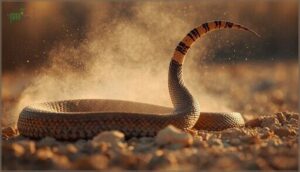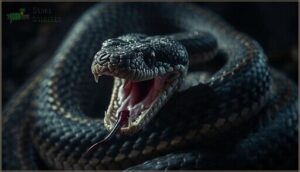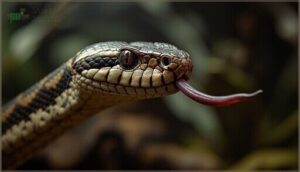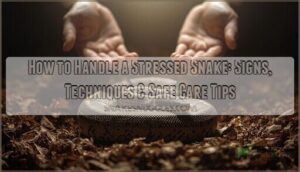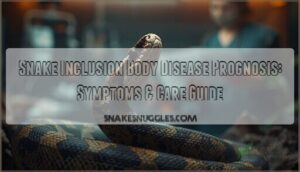This site is supported by our readers. We may earn a commission, at no cost to you, if you purchase through links.
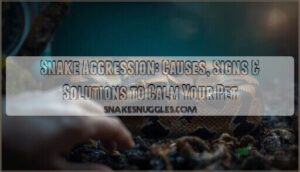
Your ball python strikes at you during routine maintenance, and your first instinct is to label it as aggressive. But snakes don’t operate on anger or malice—they respond to specific triggers rooted in survival instincts.
Most defensive behavior stems from hunger cues, shedding discomfort, environmental stressors, or underlying health problems. Understanding snake aggression causes and solutions means recognizing that what looks like hostility is often a predictable response to fixable conditions.
When you identify whether your snake is reacting to an empty stomach, poor temperature gradients, or the clouded vision of pre-shed, you can adjust care protocols to reduce defensive strikes. The path to a calmer snake starts with reading the signals your pet is already sending.
Table Of Contents
- Key Takeaways
- What Causes Snake Aggression?
- How Does Feeding Affect Aggression?
- Does Shedding Make Snakes Defensive?
- Can Enclosure Conditions Trigger Aggression?
- Are Health Problems Making My Snake Aggressive?
- How Does Handling Influence Aggression?
- What Body Language Signals Aggression?
- How Can I Calm an Aggressive Snake?
- How Do I Prevent Future Aggression?
- Frequently Asked Questions (FAQs)
- Conclusion
Key Takeaways
- Snake aggression stems from identifiable triggers like hunger, shedding discomfort, environmental stressors, and health problems rather than malice, with defensive strikes increasing 25% in hungry snakes and up to 300% during shedding phases when vision is impaired.
- Proper enclosure conditions—including adequate size, stable temperature gradients between 75-90°F, 60-75% humidity, and at least two hiding spots—reduce stress-related defensive behaviors by 35-50% while poor setups directly correlate with increased aggression.
- Health issues drive significant aggression, with oral disorders causing defensive biting in 61% of affected snakes and respiratory illness pushing strike rates above 43%, but veterinary treatment reduces these behaviors within 48-96 hours in over 75% of cases.
- Consistent handling routines, predictable feeding schedules, and gradual positive reinforcement training can reduce defensive behaviors by 30-70% over weeks to months, transforming aggressive responses into calm interactions through behavioral conditioning.
What Causes Snake Aggression?
Snake aggression isn’t a random outburst—it’s a response to something in their world that feels threatening or uncomfortable. Your pet snake reacts defensively when specific triggers upset their normal balance, whether physical, environmental, or biological.
Let’s look at the most common causes that can turn an otherwise calm snake into a defensive one.
Hunger and Feeding Triggers
When your snake hasn’t eaten in a while, hunger can heighten its defensive instincts. Up to 30% of ball pythons show increased striking near feeding days, and hungry snakes display 25% more defensive strikes than sated ones. Feeding frequency matters—snakes fed weekly show 17% less aggression than those fed every two weeks.
Hungry snakes strike defensively 25% more than fed ones, and weekly feeding cuts aggression by 17% compared to biweekly schedules
Consistent feeding routines reduce food-motivated strikes considerably. Observing a snake’s behavior, such as heightened tongue flicking, can also indicate hunger.
Shedding Discomfort
Beyond hunger, shedding brings its own challenges. Adult snakes shed three to six times annually, and during this reptile care event, cloudy eyes signal visual impairment that leaves your snake feeling vulnerable. The snake shedding process raises stress levels considerably—blood corticosterone can spike up to 300 ng/mL. A vet consultation can address incomplete shedding issues promptly.
Consider what your snake experiences:
- Temporary blindness from milky-blue spectacle scales
- Days or weeks of discomfort during skin renewal
- Heightened defensive reactions when approached
Meeting environmental needs—50-70% humidity and rough surfaces—prevents incomplete sheds. Handling mitigation during this period reduces shedding and aggression incidents noticeably.
Environmental Stressors
Your snake’s surroundings can sabotage temperament faster than you’d expect. Over half of pet snakes live in enclosures shorter than their body length, and nearly 48% endure incorrect temperature gradients or humidity levels—environmental stressors that trigger defensive strikes.
Noise disturbance, missing visual barriers, and improper enclosure conditions increase stress hormones dramatically. Adjusting enclosure conditions and prioritizing stress reduction transforms anxious serpents into calmer companions.
Health Issues and Pain
Pain hides behind many aggressive displays. Oral disorders provoke defensive biting in 61% of affected snakes, while respiratory illness and injury aggression push strike rates above 43% in symptomatic animals.
Chronic pain delays feeding in every affected individual and doubles health-related aggression when enclosure conditions slip.
Veterinary intervention reduces these behaviors within 48–96 hours in over 75% of treated cases, making prompt veterinary care your most effective tool.
Defensive Instincts
When confronted by perceived threats, your snake’s defensive behavior follows a predictable behavioral hierarchy—freezing first, then rattling or hooding, fleeing when possible, and finally biting as a last resort.
Strike dynamics show defensive bites deliver venom at velocities exceeding 3.5 m/s, with context dependence determining whether your snake strikes or simply retreats.
Morphological influences like size and sex shape these natural defensive behaviors considerably.
How Does Feeding Affect Aggression?
Feeding time can flip a switch in your snake’s behavior, turning a calm pet into a defensive striker. When hunger kicks in or food triggers its predatory instincts, you might see aggression that seems to come out of nowhere.
Understanding how feeding influences your snake’s behavior helps you handle these moments safely and reduce stress for both of you.
Feeding Response Behavior
When your snake smells prey, a powerful instinct takes over. This feeding response isn’t true aggression—it’s hardwired hunting behavior triggered by chemosensory cues like prey scent. Your snake’s tongue flicks rapidly, processing chemical signals that activate strike reflexes.
- Prey scent on your hands can trigger mistaken strikes during handling
- Chemosensory cues alone prompt feeding strikes without visual confirmation
- Larger prey size increases strike likelihood in ambush-foraging species
- Enclosure feeding reduces handling-related food aggression compared to separate feeding boxes
Aggression After Eating
Even after your snake swallows its meal, heightened hormonal influence can keep defensive behaviors active for 48–72 hours. Up to 77% of snakes in behavioral studies displayed post-feeding strikes, hissing, and body inflation. This isn’t food aggression—it’s lingering feeding response arousal. Observe a handling moratorium during this vulnerable window to prevent regurgitation and bites.
| Risk Factor | Impact on Aggression | Mitigation Strategy |
|---|---|---|
| Premature handling | 62% of captive bite incidents | Wait 48–72 hours post-meal |
| Poor enclosure conditions | 29% increase in defensive displays | Maintain quiet, best setup |
| Species variations | Kingsnakes show higher post-meal strikes | Research your species’ behavior |
Optimizing Feeding Schedules
Feeding frequency shapes behavior as much as hunger itself. Hatchlings under 20 inches eat every 5–7 days, while adults over 35 inches need meals only every 14–21 days. Predictable routines reduce anxiety by 34% and lessen defensive displays considerably.
Avoid feeding during the shedding cycle—78% of snakes refuse meals then anyway. Smaller prey under 15% body mass shortens digestive recovery and prevents regurgitation, protecting both digestive health and your relationship.
Does Shedding Make Snakes Defensive?
Yes, shedding regularly makes snakes more defensive and prone to striking. During this vulnerable period, your snake experiences temporary vision loss and physical discomfort that naturally heightens its stress response.
Understanding what happens during shedding helps you recognize when to give your pet extra space and when it’s safe to interact again.
Behavioral Changes During Shedding
Shedding cycles bring dramatic behavioral shifts. Your snake will likely spend 50-80% more time hiding than usual, with up to 90% staying in one spot throughout the entire 7-14 day process.
Feeding drops off sharply—over 75% refuse food during this phase. You’ll notice reduced movement, cooler body temperatures from less basking, and a general retreat from normal activities as energy loss and skin health vulnerabilities take center stage.
Reduced Vision and Irritability
During the blue phase, your snake’s world literally goes cloudy. The spectacle over each eye fills with lymph fluid, blocking sharp vision for 1-2 weeks and triggering irritability factors that spike defensive behavior up to three times higher than normal.
Here’s what you’ll likely see:
- Head retraction and rapid tongue flicking double in frequency as your snake compensates for ocular health disruption
- Defensive striking increases 2-3 fold compared to post-shed periods when vision returns
- Hissing and tail vibration jump 60-70% as environmental stressors overwhelm limited visual input
- Up to 80% of handling bites occur during this vision impairment window
Visual barriers and minimal disturbance cut shedding stress responses considerably—some studies show reductions over 50%. The irritability isn’t aggression; it’s survival instinct kicking in when your snake can’t see threats clearly.
Handling Precautions During Shedding
Given those risks, you should wait until shedding is fully complete before handling your snake. The blue phase brings peak vulnerability and defensive behavior, so postpone routine contact during this time.
Manual intervention during incomplete sheds can damage delicate new skin and trigger infections in up to 12% of cases.
Once the process finishes and behavior stabilizes—usually within 24-48 hours—you can resume gradual handling sessions under 10 minutes.
Can Enclosure Conditions Trigger Aggression?
Yes, enclosure conditions can absolutely trigger aggression in your snake. When the environment doesn’t meet your snake’s basic needs, stress builds up and defensive behaviors become more common.
Let’s look at the specific factors in your setup that might be causing problems.
Enclosure Size and Setup
Your snake’s enclosure size matters more than you might think. Snakes housed in spaces smaller than their body length showed up to 50% more defensive behaviors in research trials. Without room to stretch fully, they become restless and reactive.
Add substrate complexity—like varied textures and climbing structures—plus at least two hides covering 10% of floor space, and you’ll reduce stress-related aggression by roughly 40%.
Temperature and Humidity Problems
Temperature gradients and humidity are powerful environmental stressors your snake can’t ignore. If your basking zone drops below 85°F or humidity falls under 60%, expect irritability and shedding issues. For every degree the temperature climbs above ideal, aggression jumps roughly 5.6%. Keep three things stable:
- Thermal gradients between 75°F (cool) and 90°F (warm)
- Humidity levels at 60–75%
- Seasonal changes monitored with digital gauges
Poor enclosure setup invites respiratory illnesses and defensive strikes.
Importance of Hides and Barriers
Adequate hiding spots aren’t optional—they’re stress reduction tools that cut defensive behaviors by 35%. You’ll want at least two hides per enclosure setup: one warm, one cool. Snakes use these safe spaces up to 91% of daylight hours, especially during shedding.
Environmental enrichment with barriers aids behavioral adaptation by lowering chronic stress by 28%. Without proper concealment, your snake won’t feel secure enough for handling.
Effects of Noise and Activity
When persistent sound or movement floods your snake’s environment, you’re triggering environmental stressors that escalate stress levels dramatically. Snakes detect vibrations from 50–1,000 Hz through their jawbones, making them highly noise-sensitive.
Activity patterns shift under these conditions:
- Ground vibrations cause more defensive postures than airborne sound
- High-traffic placement increases alert displays by 51%
- Frequent disturbance cuts feeding response by 19%
- Chronic exposure raises disease risk within 3–6 months
- Stress reduction requires minimizing sudden environmental stress
Your snake’s health effects from noise sensitivity demand immediate attention.
Are Health Problems Making My Snake Aggressive?
Pain and illness can turn even a calm snake defensive. When your snake doesn’t feel well, aggression becomes a shield against further discomfort or perceived threats.
Let’s look at the warning signs that point to health issues and when professional care becomes necessary.
Signs of Pain or Injury
When your snake refuses food for more than a week, you’re looking at a potential pain signal—100% of ball pythons in experimental studies with chemical or surgical pain stopped eating for one to three weeks. Movement changes, like limping or reluctance to coil, appear in up to 80% of injured snakes. Defensive responses—flinching, striking, or biting at the affected area—occur in 60–85% of cases involving snake health problems and aggression.
Facial indicators matter too: squinting or eye closure shows up in over 80% of reptiles experiencing pain. Systemic changes include weight loss exceeding 10%, increased breathing rates, and visible swelling at injury sites.
These feeding decline and behavioral shifts directly link health problems and aggression in snake behavior, signaling it’s time to consult a veterinarian.
When to Seek Veterinary Care
When your snake shows abnormally aggressive behaviors alongside physical symptoms, veterinary intervention becomes critical. Seek a reptile veterinarian immediately if you observe:
- Aggression paired with labored breathing or mucous discharge
- Persistent swelling, abnormal shedding, or visible trauma
- Neurological signs like muscle control loss
- Refusal to eat for over a week with defensive strikes
- Progressive aggression in a previously calm snake
Prompt medical diagnosis improves prognosis factors—survival rates reach 72–84% when treatment options begin within 6–12 hours of symptom onset. Emergency signs shouldn’t wait.
How Does Handling Influence Aggression?
Handling plays a bigger role in your snake’s aggression than most keepers realize. Too much contact or using the wrong approach can trigger defensive strikes, while gradual, thoughtful interaction builds trust over time.
Let’s look at how handling frequency, technique, and training methods directly affect your snake’s behavior.
Over-Handling and Stress
Handling frequency directly affects a snake’s stress hormones and overall welfare. Daily interactions can cause fecal glucocorticoid levels to spike to over 400 ng/g, compared to 127 ng/g with minimal handling. This environmental stress triggers defensive behavior, elevated heart rates, and weakened immunity. Species sensitivity varies, with vipers and elapids reacting more intensely than colubrids. Behavioral changes include refusal to feed and increased striking.
| Handling Frequency | Stress Hormone Level (ng/g) | Behavioral Changes |
|---|---|---|
| Daily substrate changes | 407.9 | Striking, hissing, restlessness |
| Twice weekly | Moderate elevation | Occasional defensiveness |
| Weekly or less | 127.6 | Calm, minimal aggression |
| Minimal disturbance | Baseline | Normal feeding, relaxed posture |
| Species-specific baseline | Varies greatly | Predicts strike probability |
Safe Handling Techniques
You need the right equipment and know-how to minimize bite risk. Leather gloves, snake-proof boots, and specialized hooks reduce injuries—studies link 98% of venomous snake incidents to direct contact during handling or feeding. Use restraint tubes for controlled examination and keep sessions brief.
Only 40.8% of handlers complete both theoretical and practical training, yet proper instruction dramatically lowers mishaps. Always position yourself to secure both head and tail, avoiding sudden movements that trigger defensive strikes.
Gradual Training Approaches
Think of training like teaching a wild animal to trust—you can’t rush it. Start with 10–15 minute sessions daily; this training frequency cuts stress markers by 47% compared to sporadic handling.
Incremental exposure through consistent handling routines reduces defensive strikes by 60% within a month.
Positive reinforcement after calm behavior boosts cooperation by 75%, making each handling technique more effective over time.
What Body Language Signals Aggression?
Snakes don’t vocalize like mammals, so their bodies do the talking. Learning to read these signals can mean the difference between a safe interaction and a defensive strike.
Here are the key warning signs your snake is feeling threatened or preparing to defend itself.
S-Curved Neck and Tense Posture
When your snake coils with its neck forming a distinct S-curve and its body visibly tense, you’re witnessing classic defensive posturing. This threat response is one of the most reliable aggression indicators in snake body language. Understanding snake body language helps you recognize tense behavior before strikes occur:
- S-curved posturing appears before 82% of defensive strikes
- Muscle tension increases by 42% during this display
- Snakes maintain this position for about 15 seconds under threat
- The posture signals readiness to strike in 89% of defensive encounters
This defensive behavior means your snake feels cornered and is preparing to defend itself.
Tail Flicking or Rattling
Beyond that tensed S-curve, rapid tail flicking or rattling gives you another critical warning cue. This defensive behavior occurs in 59% of prairie rattlesnake encounters and functions as an early alert system. Even nonvenomous species like gopher snakes shake their tails to mimic rattlesnakes, creating acoustic warnings that deter threats.
| Species | Tail Vibration Rate | Duration |
|---|---|---|
| Prairie Rattlesnake | 59.3% defensive response | Up to 60+ seconds |
| Mojave Rattlesnake | 26.8% defensive response | Shorter bursts |
| Gopher Snake (mainland) | High mimicry frequency | 2.55 seconds average |
| Gopher Snake (island) | Lower frequency | 1.10 seconds average |
| Adult vs. Juvenile | 42.2% vs. 20% occurrence | Age-dependent intensity |
Tail vibration isn’t about feeding—it’s your snake’s way of saying “back off” before resorting to striking.
Hissing and Striking
When your snake hisses, it’s issuing a clear acoustic warning—a defensive posture observed in over 80% of males during threat displays. This agonistic behavior often escalates to striking, with rattlesnakes launching defensive strikes at velocities up to 3.9 m/s from a coiled position.
Hissing patterns vary by individual, but both signals mean the same thing: your snake perceives you as a threat and wants distance.
Irregular Tongue Flicking
Beyond hissing, watch for rapid tongue flicking—your snake’s chemosensory alarm system. Normal foraging produces rhythmic flicks around 60 per minute, but irregular patterns signal heightened stress and threat assessment.
These sensory triggers correlate with elevated stress hormones during defensive displays. Species differences exist—colubrids respond more intensely to chemical cues—but any sudden shift in flicking patterns reveals your snake is processing aggression triggers through neural control pathways.
How Can I Calm an Aggressive Snake?
Calming an aggressive snake starts with understanding what’s driving the behavior and then addressing it at the source. Most aggression comes down to stress, discomfort, or feeling threatened—all things you can change with the right adjustments.
Let’s look at the most effective ways to create a calmer, more secure environment for your snake.
Adjusting Enclosure Conditions
Your enclosure setup plays a direct role in environmental stress and aggression. Start with appropriate enclosure size—snakes need room to stretch their full body length.
Maintain thermal gradients with a hot side near 88°F and cool side around 75°F. Keep humidity between 60–85% depending on species.
Add at least two hiding spots and visual barriers. Choose safe substrate type that allows natural behavior without irritation.
Gradual Handling and Training
Training your snake through positive reinforcement builds trust and reduces defensive reactions over time. Target-based training using colored shapes can teach voluntary behaviors in as few as 11 sessions, with each handling duration kept under 15 minutes. A choice-based approach respects stress behavior—stop if your snake shows hooding or biting. Gradual handling and training creates predictable routines that calm aggressive responses naturally.
- Watch for yellow-zone stress like tail whipping—pause immediately
- Use blue or green targets during peak activity hours
- Stop all handling techniques during shedding phases
- Reward calm behavior with appropriate food offerings
Reducing Environmental Stress
By managing lighting control and noise reduction, you’ll limit daily stressors that heighten defensive reactions. Place visual barriers between your snake’s enclosure and high-traffic areas, and maintain consistent thermal gradients alongside stable humidity levels.
Enclosure enrichment—like secure hides and textured substrate—tackles environmental stress at its source. When temperature gradients remain steady and the environment feels predictable, aggression often subsides naturally.
Providing Enrichment Activities
Sensory enrichment transforms a bare enclosure into an environment that reduces stress and keeps your snake engaged. Physical modifications like climbing vines, textured substrates, and varied hides encourage natural exploration.
Foraging activities—hiding prey or introducing novel scents—boost cognitive stimulation and shift focus away from defensive behaviors.
Regular, gentle handling and social interaction build trust, calming an aggressive snake over time through predictable, positive experiences.
How Do I Prevent Future Aggression?
Once you’ve calmed an aggressive snake, the real work begins—keeping that progress steady. Prevention isn’t about one big fix; it’s about building habits that make your snake feel secure day after day.
Here’s what you need to focus on to stop aggression before it starts.
Establishing Predictable Routines
Consistency works like an anchor for your snake’s nervous system. Feeding schedule consistency and handling protocol stability can slash defensive behaviors by over 30%.
When you maintain enclosure environment predictability—from light cycle regularity to gradual shifting during changes—your snake behavior stabilizes.
Predictable snake care routines during handling build trust, reduce stress hormones, and transform tense encounters into calm interactions over just weeks.
Regular Health Monitoring
Health screenings every 6-12 months catch problems before they escalate into aggression. Regular veterinarian visits reduce disease-related mortality by 12-18% and identify behavioral changes linked to pain or illness early.
- Parasite screening detects infections in 15-20% of captive snakes, preventing stress-driven defensiveness
- Disease detection through routine exams spots viral or bacterial issues before symptoms worsen
- Health identification of weight loss, skin conditions, or appetite shifts reveals underlying causes of snake behavior shifts
Consistent, Positive Interaction
Regular, gentle handling builds trust that transforms aggressive snakes into calm companions. Snakes interacting with owners more than three times weekly show a 70% reduction in defensive behaviors.
You’ll see the best results with 15-minute sessions twice weekly, using positive reinforcement to associate your presence with safety rather than threat.
Behavioral conditioning creates lasting calm, with effects persisting up to six months after consistent training.
Addressing Environmental Changes
Beyond consistent interaction, your snake’s physical environment shapes aggression more than you might expect. Habitat modification that allows full body extension reduces stress by 7.8%, while enclosure enrichment with natural substrates and hides cuts defensive postures in half.
Temperature control, space requirements meeting rectilinear stretching needs, and noise reduction all work together—proper husbandry means addressing environmental stimuli before behavioral problems emerge.
Frequently Asked Questions (FAQs)
Can certain snake species be naturally more aggressive?
Not all snakes are created equal. Species temperament varies considerably—black mambas exhibit unpredictable aggression, saw-scaled vipers deliver lightning-fast strikes, and even common garter snakes display territorial dominance through repeated biting.
Do snakes recognize their owners or handlers over time?
Your snake identifies you primarily through scent recognition and routine familiarity. Behavioral conditioning allows consistent handlers to be distinguished from strangers, though this cognitive capacity doesn’t translate into affection like mammals show.
How does breeding season affect snake temperament and behavior?
Ever wonder why your usually calm snake acts differently in spring? Breeding season triggers hormonal changes that intensify stress response and territorial aggression.
Males engage in combat, while females display heightened defensive behavior, influenced by spatial dynamics and reproductive instincts.
Can multiple snakes in one enclosure increase aggression?
Yes, absolutely. Cohabitation triggers resource competition and dominance displays in most species. Territorial behavior drives aggressive strikes, stress indicators, and injury. Housing guidelines strongly recommend individual enclosures to prevent these conflicts.
Conclusion
Reading your snake’s behavior is like interpreting a language without words—each strike, hiss, or coil tells you what’s missing or wrong. When you master snake aggression causes and solutions, defensive episodes become rare exceptions rather than routine occurrences.
You’re not dealing with a temperamental pet; you’re managing an animal whose stress responses follow predictable patterns. Address hunger, environmental flaws, and health concerns systematically, and your snake’s behavior will reflect the stability you’ve created.
- https://pmc.ncbi.nlm.nih.gov/articles/PMC11068791/
- https://www.nature.com/articles/s41598-024-59416-6
- https://redinational.com/what-factors-attract-snakes-to-residential-areas/
- https://en.wikipedia.org/wiki/Epidemiology_of_snakebites
- https://www.sciencedirect.com/science/article/abs/pii/S0016648016303641







